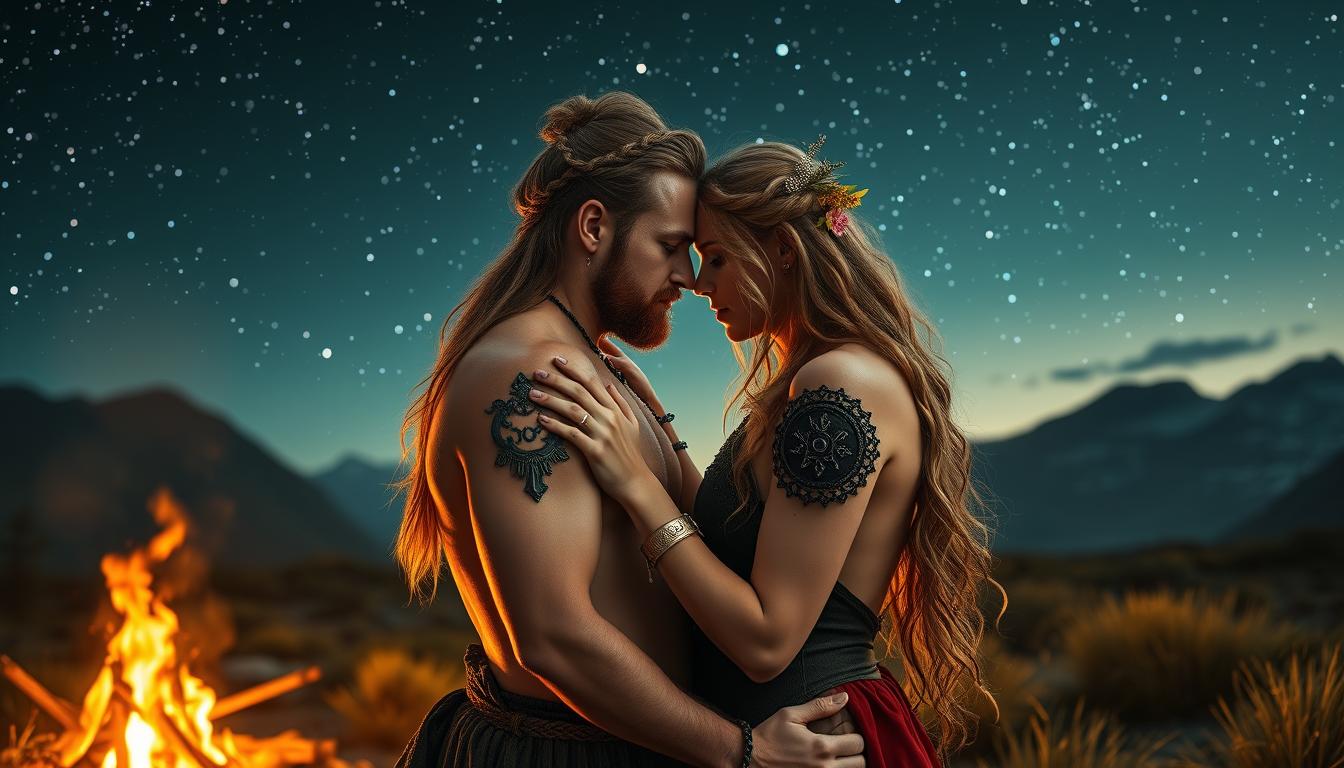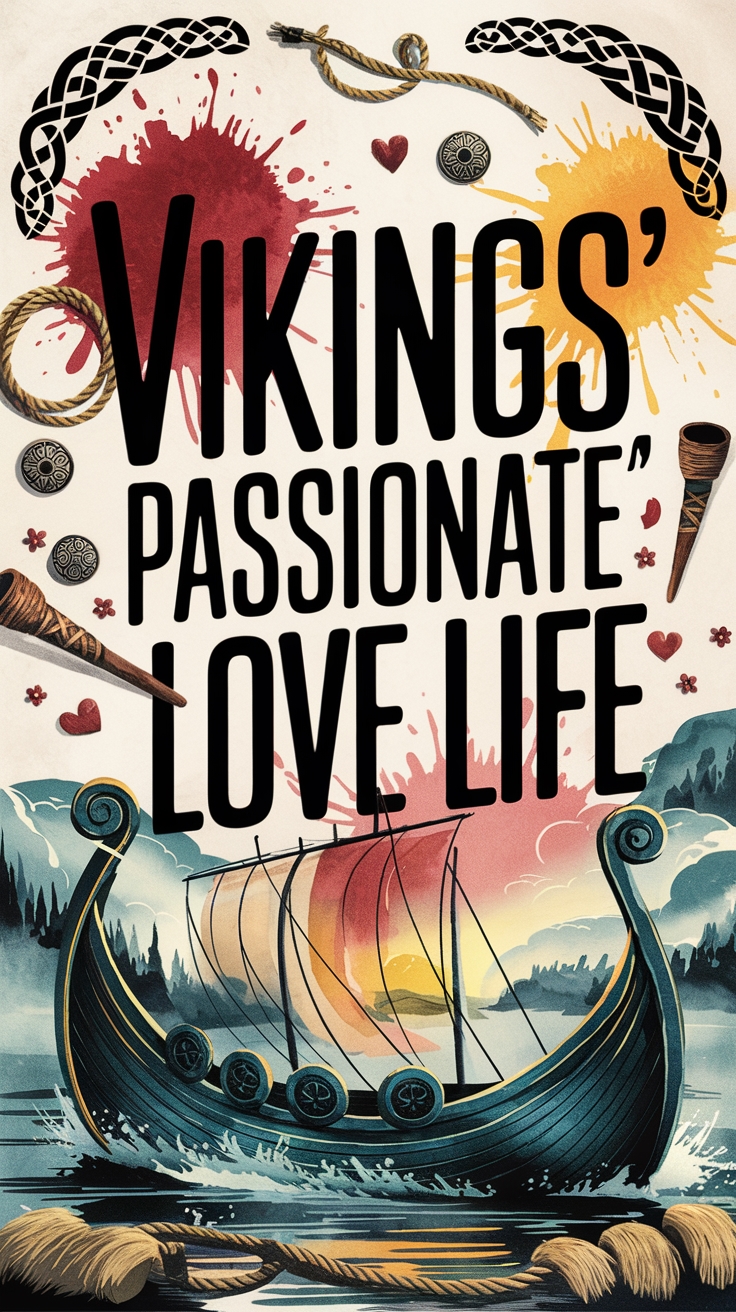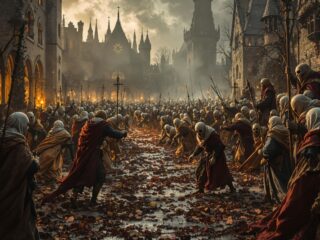Did you know Viking marriages were complex, with women possibly marrying up to five times? The Vikings’ love life was more than just violence. Their culture showed a deep understanding of relationships, blending practical needs with emotional connections.
Vikings saw love as more than just physical attraction. Marriage was a family alliance, but personal feelings mattered too. This mix of strategy and emotion made their love stories unique.
The Vikings’ love life was shaped by their social norms. Poetry, myths, and courtship rituals were key to their romance. They balanced practical needs with deep feelings, creating a rich world of human connection.
Key Takeaways
- Viking marriages were strategic family alliances
- Women could marry up to five times in their lifetime
- Consent was key in Viking marriage arrangements
- Poetry played a big role in courtship
- Love was seen through practical and emotional views
- Social gatherings helped in finding love
- Mythology greatly influenced their views on love
Viking Courtship Rituals
In ancient Norse mythology, Viking courtship was more than just romance. It was an art form that showed the warrior spirit of seafaring adventurers. It celebrated poetry, creativity, and deep emotional connections.
Skilled skalds (poets) were key in Viking romantic traditions. Their verses were powerful tools to attract lovers. These poems were not just words but meaningful expressions of admiration and desire.
Gift-giving was also important in Viking courtship. Suitors gave personal tokens to show their skill, creativity, and commitment. Jewelry, carved items, and handmade objects were symbols of romantic intent. Each gift told a story about the giver’s character and their worth as a partner.
The Vikings saw love as a mix of passion and practicality. By age 20, they expected to marry, seeing love as an emotional and strategic alliance. Their courtship rituals balanced personal attraction with community expectations. This created a unique way of forming relationships that respected both individual feelings and societal structures.
At its core, Viking love was a dance of poetry, craftsmanship, and mutual respect. It showed their deep understanding of human connection, going beyond simple romance.
Marriage Traditions in Viking Society
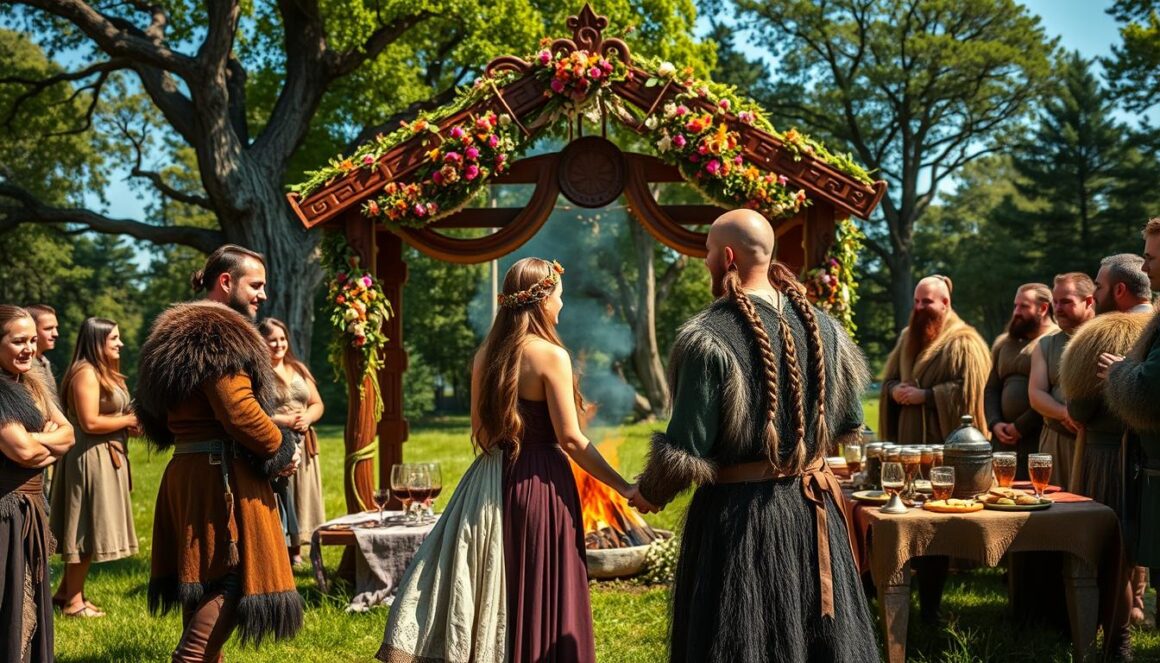
Viking society placed great importance on marriage. It was more than just a union between two people. Norsemen traditions saw marriage as a key social bond that united families and strengthened communities.
Wedding ceremonies were grand, held on Frigg’s Day to avoid bad luck. Marriages were often arranged, but love matches were common among the common folk. The bride and groom went through rituals to show their commitment and seek divine blessings.
A unique part of Viking weddings was the exchange of ancestral swords. This symbolized the transfer of family protection and lineage. The groom would retrieve a sword from an ancestor’s grave, marking his transition to manhood. Blood sacrifices, like a goat, were made to thank the gods and wish for marital prosperity.
Another custom was the “morning gift,” where the groom gave his bride a valuable token after their first night together. The community was involved, with up to six witnesses ensuring the marriage was consummated. Mead was plentiful, showing the joy and happiness of the community.
These detailed marriage practices showed the Vikings’ respect for family, tradition, and spiritual ties. Their weddings were not just personal but also complex social rituals. They strengthened community bonds and kept cultural traditions alive.
Role of Women in Viking Love Life
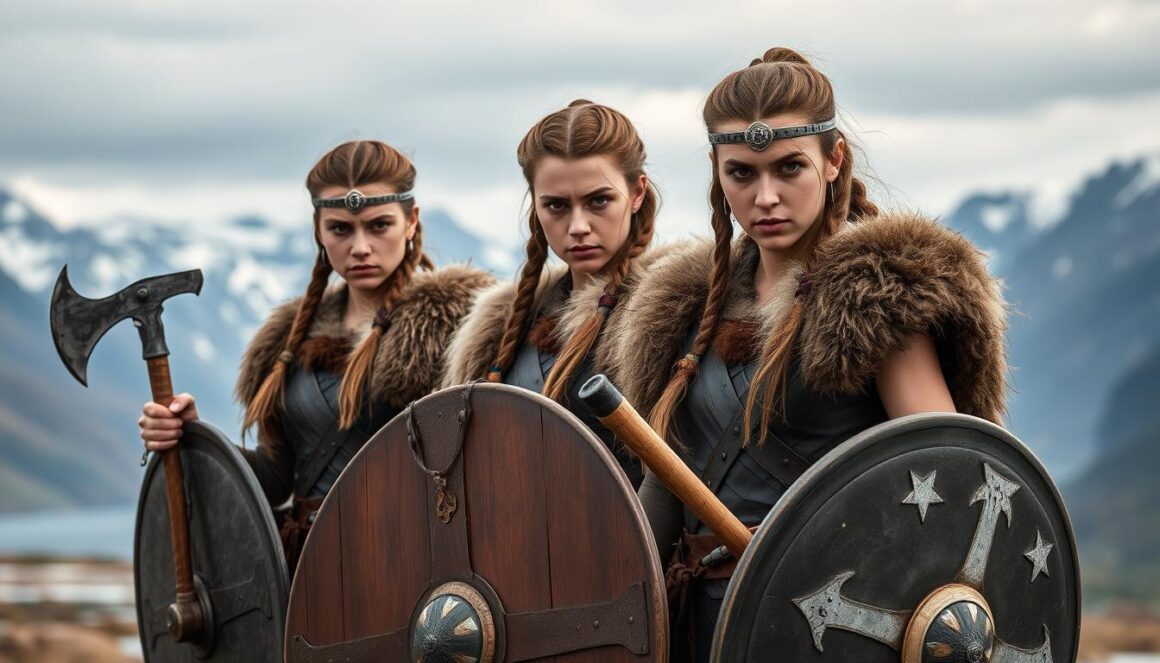
In Norse culture, women played a unique role that defied traditional norms. They enjoyed a lot of freedom in their love lives, with rights that were ahead of their time. Their bravery in battle also showed in their personal lives, where they made big decisions about marriage and family.
Marriage in Viking society was more than just love; it was a strategic partnership. Women could own land, start divorces, and had strong legal rights. About 50% of Viking women had the power to make important decisions, like marriage contracts and managing the household budget. They were key to keeping families going, even when their husbands were away.
The Viking marriage system was complex, with women’s roles far beyond what we expect today. They took care of homes, made textiles, and kept the family’s finances stable. Archaeological finds, like women’s graves with household items and keys, show their vital role in society.
Viking women could get married between 12 and 15 years old, with some say in the decision. Their marriages often came with dowries of land, animals, and valuable items. These deals helped build strong social networks and community ties.
The shieldmaiden is a symbol of Viking women’s diverse identities. These brave warriors fought alongside men and became famous in Norse stories. Their courage and independence made them attractive partners, showing a culture that valued strength and skill over strict gender roles.
Importance of Fidelity Among Vikings
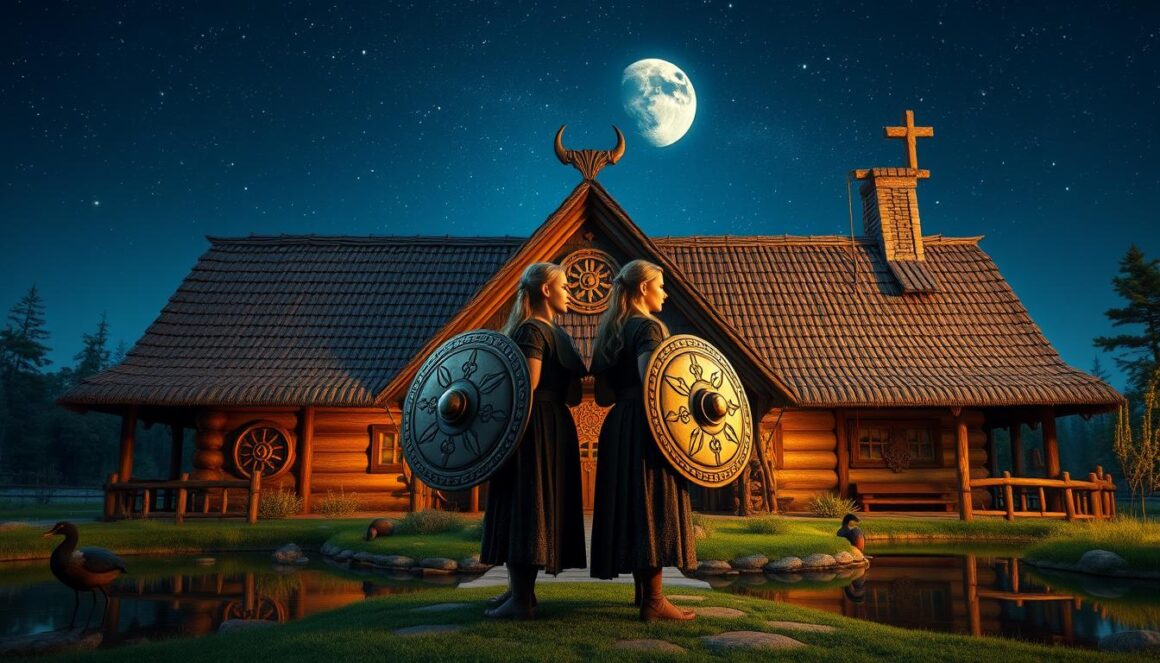
In Norse culture, fidelity was more than just love. It was a key part of their moral code, known as the Nine Noble Virtues. Loyalty was at the heart of their values.
Vikings saw faithfulness as essential for personal honor and social standing. They believed keeping promises was sacred. Breaking an oath or betraying trust could lead to severe penalties.
Loyalty went beyond romantic love. It included commitments to family, friends, and community. A Viking’s reputation was built on keeping promises.
Self-discipline was key to staying faithful. Vikings respected those who controlled their impulses and kept their word. They saw loyalty as a sign of personal strength.
Even though men and women had different roles, the value of fidelity was the same. Those who showed loyalty were celebrated. Those who didn’t faced shame and could be isolated from their community.
Viking Divorce Procedures
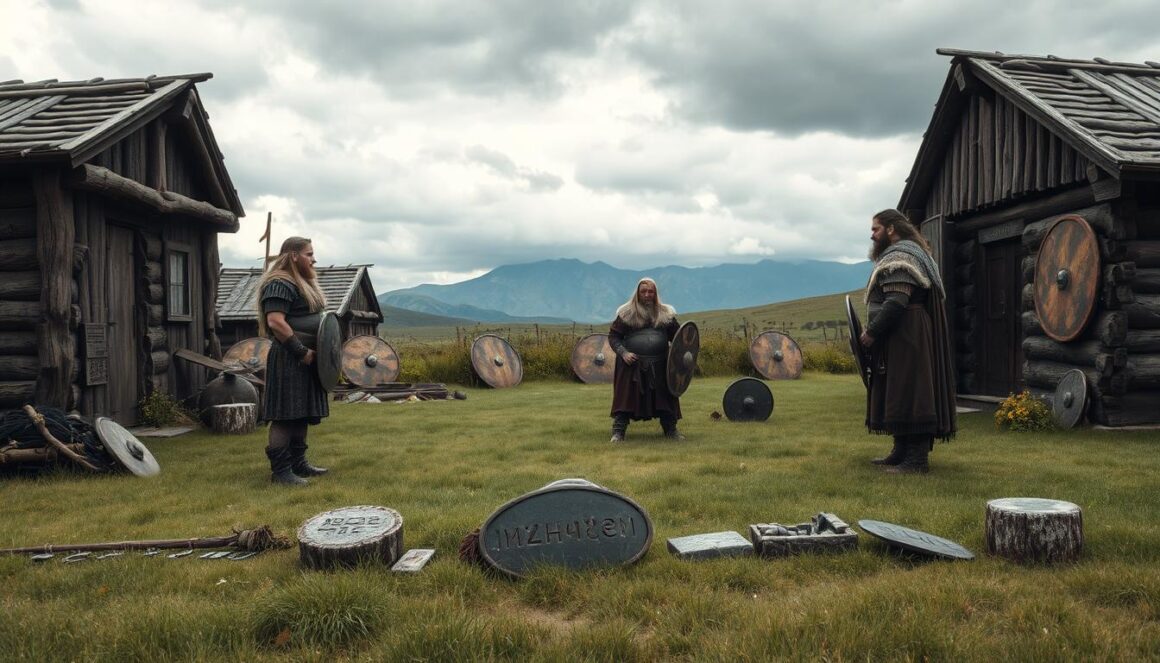
In the Viking way of life, divorce was surprisingly progressive and accessible. Norse culture allowed both men and women to initiate divorce proceedings. This was a remarkable approach for medieval societies. Couples could legally separate for various reasons, including domestic violence, prolonged absence, or fundamental incompatibility.
Viking women had significant legal rights during divorce. They could claim half of the couple’s estate and retain their original dowry. If a husband struck his wife three times, she could immediately seek divorce. Foreign travelers often expressed astonishment at the remarkable freedoms Viking women enjoyed in ending marriages.
The divorce process typically involved a public declaration made in front of witnesses at the local thing (community assembly). Children’s custody varied based on age and family status. Infants usually remained with their mothers, while older children’s arrangements depended on family wealth and social standing.
Interestingly, the Nordic legacy revealed complex divorce protocols. Some separation reasons included financial mismanagement, lack of children, or a husband’s failure to fulfill marital obligations. The legal framework protected both parties, ensuring fair property distribution and preventing long-term conflicts.
These divorce procedures showed the Vikings’ pragmatic approach to relationships. Their society valued individual rights and practical solutions. This challenged modern perceptions of medieval marriage practices.
Love Symbols and Tokens
In Ancient Norse mythology, love tokens were key in Viking romance. These symbols were more than gifts; they showed deep emotional bonds and cultural importance.
Runestones were powerful love messages in the Viking era. They were carved with runic inscriptions, making them lasting declarations of love. Warriors and lovers carved their feelings into stone, creating lasting memorials.
Jewelry was deeply meaningful in Viking life. Brooches, arm rings, and pendants were symbols of love and protection. Thor’s hammer pendants, for example, protected loved ones. Intricate knot designs showed eternal love, showing Vikings’ artistic side in love.
Gifts were vital in Viking courtship. Suitors made meaningful items to show their skill and dedication. These gifts included handmade jewelry, wooden items, and metalwork that showed creativity and tradition.
Freyja, the Norse goddess of love and fertility, inspired these traditions. Her story connected love, spirituality, and daily life in Viking society. Wedding bands, like her necklace Brísingamen, symbolized eternal love and commitment.
Viking Love Stories and Legends
Scandinavian history is filled with epic love stories that go beyond simple romance. Ancient Norse mythology is full of passionate tales. These stories involve gods, goddesses, and mortal lovers, showing how they understood love and devotion.
The legend of Freyr and Gerðr shows the deep side of Viking love. Freyr’s search for Gerðr was filled with magic and big sacrifices. He gave up his magical sword to be with her, showing love’s power over personal strength.
Norse mythology saw love as complex. Goddesses like Freyja were both loved and warlike, showing the emotional depth of Viking society. Her search for her husband Óðr across lands showed commitment beyond usual love.
The sagas show love as a force that can change lives. Tragic stories like Sigurd and Brynhild show how betrayal can lead to great sorrow. These stories highlight the deep emotions of Viking love.
These ancient stories give us a peek into Viking emotional lives. Love was more than personal; it was a cultural force shaping identity in Scandinavian society.
Conclusion: Vikings’ Passionate Love Life
The Vikings’ love life is a complex and deep part of Norse culture. They saw relationships as more than just warrior bonds. Their love stories show a rich emotional world.
Viking society saw love as a mix of personal feelings and social needs. Their marriages were based on respect and family ties. This shows a culture that valued love and social order.
Looking into the Vikings’ love stories, we find a surprising side of them. Their tales of honor, sacrifice, and love are timeless. They remind us that deep emotions connect us across time and cultures.
Reflecting on the Vikings’ love, we see a society more complex than we thought. Their view on love and relationships gives us a deep look into their culture. It shows how they balanced emotions with social thinking.
FAQ
Were Vikings really romantic?
Yes, Vikings were surprisingly romantic. They loved poetic wooing and complex courtship rituals. Skalds (poets) would write beautiful verses to win a lover’s heart.
Suitors would give personalized gifts to show their love and skill.
Did Viking women have any say in marriage?
Viking women had more freedom than many women today. They could start a divorce, own property, and choose their partners. The shield-maiden idea showed the value of strong, independent women.
How did Vikings approach divorce?
Vikings had fair divorce rules. Both men and women could start a divorce publicly. Property was divided fairly, with women often keeping their assets.
Children were split based on gender.
What were some important Viking love symbols?
Runestones and jewelry were key love symbols. Thor’s hammer pendants meant protection, and certain knots showed eternal love. These items held deep meaning in Norse relationships.
How important was fidelity in Viking culture?
Fidelity was key to honor and loyalty. While men were often more forgiven, cheating could lead to serious consequences. This included divorce, losing property, and social shame.
Did Viking love stories only involve warriors?
No, Viking love stories were varied. They included romantic tales, mythological romances, and passionate stories. Figures like Freyja and legendary couples showed the complexity of Viking love.
What role did poetry play in Viking romance?
Poetry was vital in Viking courtship. Skalds used their verses to win hearts, seen as powerful and magical. These poems expressed admiration, desire, and emotional bonds.
Were Viking marriages typically arranged?
Arranged marriages were common, but love matches happened too. Marriages were strategic alliances, but individuals could influence their choices, mainly in lower classes.
How did Vikings celebrate weddings?
Viking weddings were grand, lasting several days. They involved feasting, drinking, and rituals. The “morning gift” was a special tradition where the groom gave a valuable gift the next morning.
What made Viking love culture unique?
Viking love culture was unique because it mixed practicality with passion. They valued honor, loyalty, and emotional bonds. Their love was a blend of warrior spirit, poetry, and deep relationship understanding.

